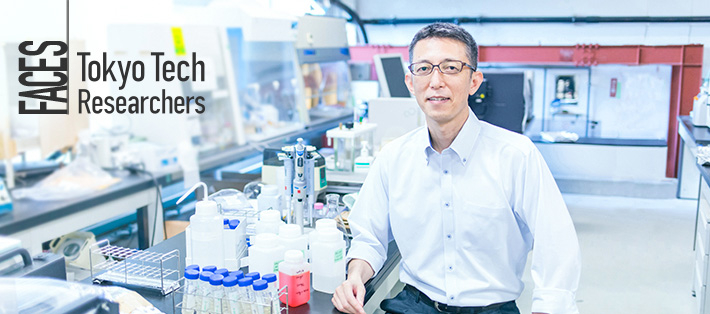
Issue 43
Chihiro Yoshimura
School of Environment and Society, Department of Civil and Environmental Engineering
Environmental problems such as global warming, plastic pollution, and ecosystem degradation are widespread and increasingly complex. Many of these problems are related to water.
Among the Sustainable Development Goals (SDGs), which are international goals for achieving a better and more sustainable world by 2030, there are goals to "Ensure availability and sustainable management of water and sanitation for all" and "Conserve and sustainably use the oceans, seas and marine resources for sustainable development." Recently, efforts to improve water usage and the aquatic environment are gaining momentum worldwide.
Under these circumstances, Professor Chihiro Yoshimura (Department of Civil and Environmental Engineering, School of Environment and Society) has been researching the aquatic environment for many years, with a focus on rivers and lakes.
Aquatic environments are essential to human life
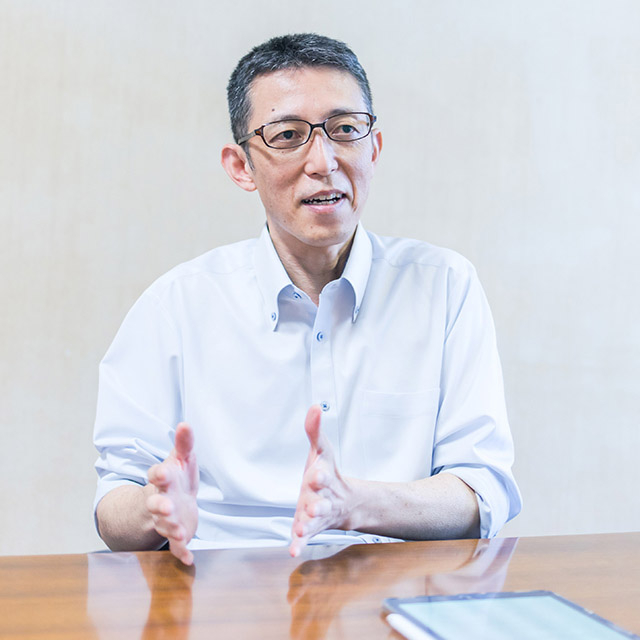
"From early on, I wanted to contribute to a field that directly relates to people's lives; for example, social infrastructure," explains Yoshimura. "With that in mind, I chose the Department of Civil Engineering at Tokyo Tech and joined a laboratory for environmental water quality engineering focusing on aquatic environments such as rivers and lakes. I have been working on this research theme ever since."

An aquatic environment includes not only rivers and lakes, but also the activities of people living in the surrounding areas, and the ecosystems affected by those activities. Yoshimura's research involves assessing such aquatic ecosystems from the viewpoint of water safety and the living environment. Based on those assessments, he considers how to create sustainable relationships between regional communities and nature.
Yoshimura is currently focusing on three areas: "environmental photochemistry," "development of water quality models," and "evaluation of ecosystem functions."
Understanding how photochemical reactions affect water quality and biocenosis
The first area, environmental photochemistry, deals with photochemical reactions in the natural environment. As the name suggests, photochemical reactions are reactions caused by light energy. Yoshimura is exploring the photochemical reactions that occur in aquatic environments and their engineering applications.
Organic compounds such as pesticides and pharmaceuticals flow into rivers through various types of wastewater and sewage. Many of these substances exhibit endocrine disruption and ecotoxicity in aquatic ecosystems, while others are degraded by photochemical reactions. The photosynthesis of phytoplankton, algae, etc., is well known as a photochemical reaction. However, photochemical reactions that do not involve living organisms are actually always occurring in water exposed to light. Together with biodegradation by microorganisms, such photodegradation is recognized as a self-cleaning action of the environment.
Furthermore, in recent years, marine pollution has been occurring in the form of microplastics. We know that these plastics are also degraded in the environment mainly by the two actions of photodegradation and biodegradation. In this way, photochemical reactions are important reactions in aquatic environments. Understanding the processes of photochemical reactions in organisms and substances will enable us to better manage chemical substances, aquatic environments, and ecosystems.

Degradation of organic compounds in aquatic environments can occur through photochemical reactions as well as by bacteria. Photochemical reactions can be divided into direct photolysis and indirect photolysis via radicals1. (Zhongyu Guo, et al., Water Research. (2022))
Water treatment technology using photocatalysts
However, not much progress has been made in understanding photochemical reactions in aquatic environments. This is one of the reasons why the management and regulation of pollutants are inadequate. Therefore, by researching environmental photochemistry, Yoshimura hopes to propose effective management methods for aquatic environments. He also aims to realize new water treatment technologies by applying photochemical reactions in aquatic environments.
In the laboratory, Yoshimura acquires data through the organic combination of modeling based on surveys of rivers and lakes in Japan and overseas, and on experiments related to environmental photochemistry. In water treatment using photocatalysts, if technology can be developed that synergizes with the photochemical reactions in water, it would be possible to secure safe water even in areas where electricity is not available, as long as there is sunlight. This technology could be used in regions such as developing countries and mountainous areas.

Photocatalytic reactor. The center of the device is equipped with a xenon lamp, which emits light in a spectrum similar to that of sunlight. Test tubes are placed around the lamp which induces photochemical reactions. This makes it possible to replicate the photochemical reactions that occur under various water quality conditions. In other words, it is possible to determine how organic pollutants in water change due to photochemical reactions. Furthermore, by obtaining concentration data over time, it is possible to clarify elements such as reaction pathways and reaction rates.
Using simulations to understand lake ecosystems and achieve environmental conservation
Yoshimura's second area of focus is development of a water quality model. This is an effort to use a numerical model to describe the aquatic environment. Yoshimura constructed a water quality model for lake water. For example, if a pollutant flows into a lake, it is possible to use a simulation to predict how the pollutant will diffuse over time, and how the biomass of organisms in the water will change. It is also possible to visualize the space-time distribution of these concentrations. Incidentally, Yoshimura is currently focusing on lakes because chemical and biological reactions are more likely to occur in lake water than in rivers.
One result of this research was an international project that targeted Lake Tonle Sap in Cambodia and was led by Yoshimura from April 2016 to March 2022 (JST/JICA-SATREPS).
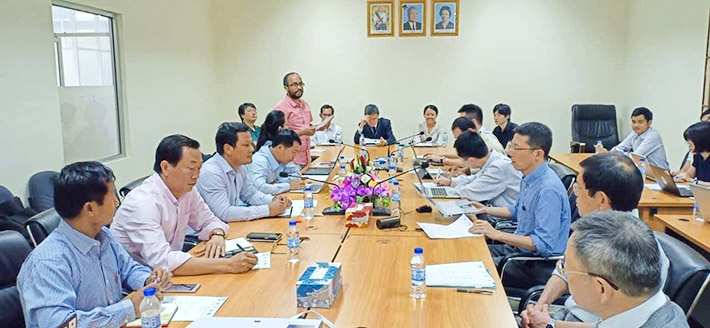
Meeting on the environmental management of Lake Tonle Sap at the Cambodian Tonle Sap Authority
Lake Tonle Sap is located in the central region of Cambodia. It boasts the largest area of any lake in Southeast Asia, with a total length of about 100 kilometers. Local people use Lake Tonle Sap and its floodplain for farming and fishing. The vast flood plains that are temporarily submerged in water also play an important role in maintaining biodiversity in the Mekong Basin. However, over the past decade or so, development has progresse in the basin, and environmental pollution of the lake has become a growing concern.
A floating village on Lake Tonle Sap
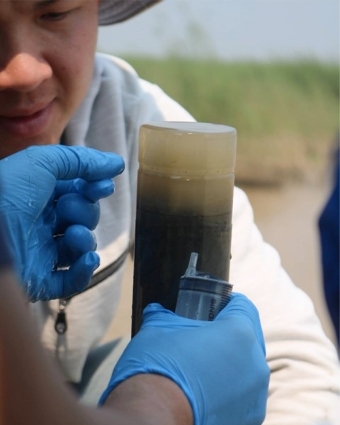 Conducting an on-site survey of sediment dynamics
Conducting an on-site survey of sediment dynamics
 Conducting an on-site survey of sediment dynamics
Conducting an on-site survey of sediment dynamics
On how the project started, Yoshimura explains, "When I first visited Tonle Sap Lake in 2016, there were concerns about how the lake was being impacted by the construction of a dam and hydroelectric power plant upstream on the river. At that time, the lake was a rich and valuable ecosystem, and I felt that it was worthy of being registered as a natural heritage site. I thought it would be very meaningful to scientifically clarify the characteristics of the lake for having it designated as a world natural heritage site and ensuring conservation. Therefore, I started collaborative research with a researcher from the Institute of Technology of Cambodia."
"Eutrophication2 had become a problem at that time, and it created the issue of excess organisms and organic matter. This makes it difficult to use the lake water as tap water and agricultural water. Furthermore, if oxygen deficiency occurs as a result of eutrophication, the fish population will drop significantly. It was therefore necessary to ascertain the movement in levels of nutrient sources such as phosphoric acid."
In this project, Yoshimura collaborated with laboratories inside and outside of Tokyo Tech to construct a water quality model for the movement of water and various substances that flow from rivers into lakes, thereby enabling replication through simulations.
Simulation of phytoplankton concentration in Lake Tonle Sap. Based on seasonal flood patterns, sediment dynamics, and phosphorus dynamics, the simulation replicates the space-time distribution of phytoplankton concentration.
A water quality model constructed in this way enables various simulations simply by changing the parameters. For example, because it is possible to predict changes in the aquatic environment of lakes as global warming progresses, Yoshimura plans to apply this water quality model to other lakes, including those in Japan.
"Currently, management of aquatic environments in Japan is based on environmental monitoring, which usually examines water quality and species," explains Yoshimura. "Environmental monitoring is an important task for clarifying the impact of environmental changes on ecosystems. However, countermeasures inevitably fall one step behind. By using simulations to predict future impact, we can implement effective measures in advance instead of trying to improve things after they have deteriorated."
For example, there are about 3,000 dammed lakes in Japan. Presently, water quality management is based on environmental monitoring. However, in the future, applying water quality models will enable more rational environmental management. Therefore, Yoshimura is currently working on a project running from April 2021 to March 2023 in collaboration with the Water Resources Environment Center (WEC). The project aims to understand photochemical reactions on the water surface of dammed lakes and to model the decomposition of organic pollutants. This project also comprises the generation of blue-green algae3 and the photodecomposition reaction of organic matter, particularly in dammed lakes.
"Until now, dam managers have engaged in trial-and-error for measures to prevent blooming of blue-green algae," explains Yoshimura. "In the future, I would like to formulate efficient countermeasures by conducting simulations using water quality models. In addition to being desirable in terms of various types of water usage, suppressing the growth of blue-green algae will also lead to conservation of dammed lake ecosystems."
The international project targeting Lake Tonle Sap ended in March 2022. Currently an organization established at the Institute of Technology of Cambodia is responsible for conservation and management of Lake Tonle Sap. "In environmental conservation research, it is also important for local people to take ownership of conservation and management of the natural environment. This will make it possible to achieve sustainability," explains Yoshimura. Therefore, the project also focused on providing training to the local community. I have high expectations for their research results and environmental conservation efforts, and I will certainly keep an eye on their future activities."
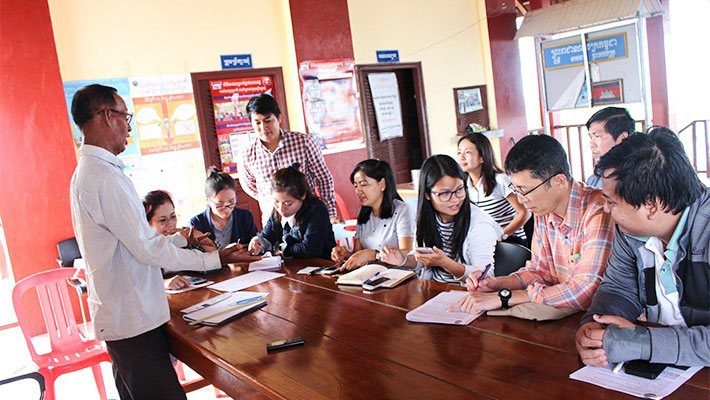
Meeting with the mayors of floating villages. While obtaining cooperation for surveys in local villages, Yoshimura also provided training for young Cambodian researchers, university students, and local residents.
Exploring ecosystem management methodologies with social benefits
Yoshimura's third area of focus is the evaluation of ecosystem functions. He states, "Of course, preventing pollution is extremely important; however, as a further step, I would like to achieve environmental management that can better utilize the functions of the ecosystem. This means considering environmental management methods that increase the benefits to society while maintaining the ecosystem. For example, making it possible to have high-quality fishery resources while still maintaining a healthy ecosystem. Therefore, by making full use of an aquatic environment model that incorporates ecosystem functions, we are tackling the issue of what kind of environmental management can enhance ecosystem services."

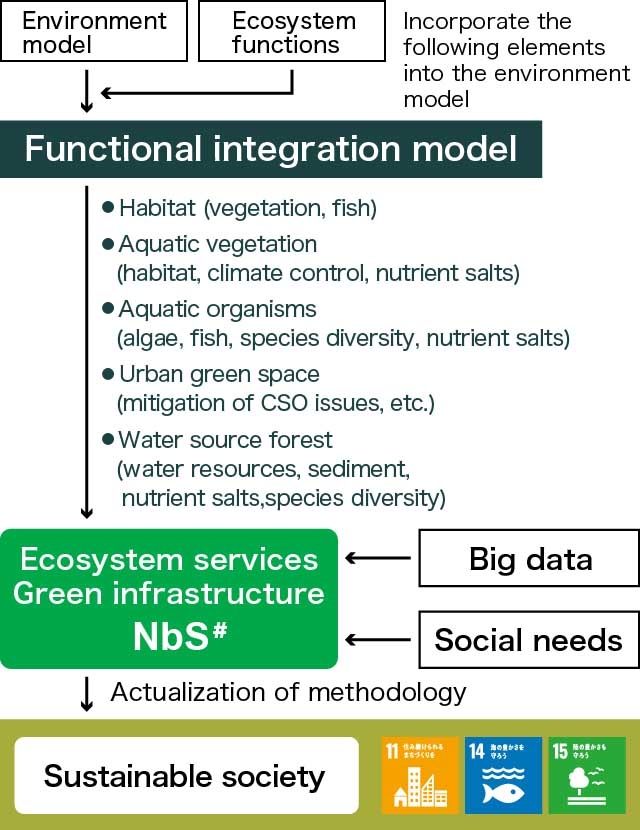 Integration of ecosystem services into aquatic ecosystem models. Improving and integrating various environmental models and enabling the quantitative evaluation of ecosystem functions and ecosystem services will contribute to achieving a sustainable society.
Integration of ecosystem services into aquatic ecosystem models. Improving and integrating various environmental models and enabling the quantitative evaluation of ecosystem functions and ecosystem services will contribute to achieving a sustainable society.
#: Nature-based Solutions (solutions to social issues rooted in nature)
Ecosystem services are the benefits that human society receives from ecosystems. This concept has attracted attention in recent years. Ecosystem services contain everything that society depends on from the natural world, such as water and fish. For example, by adding a parameter that describes the growth of fish to the water quality model, it is possible to determine the extent to which a particular method of farming in the river watershed will ultimately change fishery production. Another example would be determining the approximate amount of water usage in an upstream dammed lake that would make it impossible to maintain the fishery production amount.
Furthermore, if it is possible to use simulations to visualize the benefits of the aquatic environment for residents living nearby and to predict future effects quantitatively, we will be able to optimize use of the aquatic environment for society. In recent years, this concept has been expressed as "green infrastructure" or "nature-based solutions (NbS)." These ways of thinking emphasize utilizing the mechanisms of nature and ecosystems in society. Such efforts will reduce carbon dioxide emissions and lead to the achievement of a sustainable society. "The aquatic environment is part of nature, so I would like to contribute to society by developing tools for the aquatic environment," says Yoshimura. "Ultimately, I hope that this will lead to achieving SDGs."
 Integration of ecosystem services into aquatic ecosystem models. Improving and integrating various environmental models and enabling the quantitative evaluation of ecosystem functions and ecosystem services will contribute to achieving a sustainable society.
Integration of ecosystem services into aquatic ecosystem models. Improving and integrating various environmental models and enabling the quantitative evaluation of ecosystem functions and ecosystem services will contribute to achieving a sustainable society.
#: Nature-based Solutions (solutions to social issues rooted in nature)
The joy of aquatic environment research as an interdisciplinary field
Yoshimura describes the joy of conducting his research as follows: "I studied abroad at the Swiss Federal Institute of Aquatic Science and Technology (Eawag) in Switzerland for one year during my second year in the doctoral program. Eawag is a national research institute specializing in water and environment. My experience at Eawag was the first time that I belonged to an ecology laboratory and learned how interesting ecology truly is. My background is in engineering, but being exposed to research fields in the sciences greatly broadened my horizons. In fact, the aquatic environment is an interdisciplinary field that involves both engineering and science. I felt that one of the main appeals of my research is the ability to learn from both disciplines."
As initiatives for SDGs are currently gaining momentum worldwide, Yoshimura's research is attracting even greater attention. "From among the 17 SDGs, my research is deeply related to Goal 6 'Ensure availability and sustainable management of water and sanitation for all,' Goal 14 'Conserve and sustainably use the oceans, seas and marine resources for sustainable development,' and Goal 15 'Protect, restore and promote sustainable use of terrestrial ecosystems, sustainably manage forests, combat desertification, and halt and reverse land degradation and halt biodiversity loss.' That being said, the SDGs have not changed my research. All the SDGs are important social issues that should have been resolved even before being defined as SDGs. I will continue to conduct research on the aquatic environment with the aim of achieving a sustainable society."
In closing, Yoshimura gave the following message to young people aiming to become researchers. "Personally, studying abroad in Switzerland was an invaluable experience. Therefore, rather than staying at the same university from undergraduate to graduate school, I recommend that you actively change your environment and take on new challenges, such as studying abroad, moving to another university, or finding employment. Also, beginning from their time in school, I hope that students will earnestly pursue their own interests and confront their problem awareness without being influenced by the thoughts of people around them. Taking such an attitude will broaden your horizons and enrich your life."
1 Radicals
Highly-reactive atoms and molecules containing unpaired electrons. Includes reactive oxygen species.
2 Eutrophication
A natural phenomenon in which closed bodies of water such as lakes and dammed reservoirs change from oligotrophic to eutrophic with a high concentration of nutrients. This change is caused by the supply of nutrients such as nitrogen compounds and phosphoric acid from the watershed.
3 Blue-green algae
A state in which microalgae grow in large numbers near the water surface in lakes and marshes where eutrophication is progressing. This phenomenon makes the water surface a blue-green color.
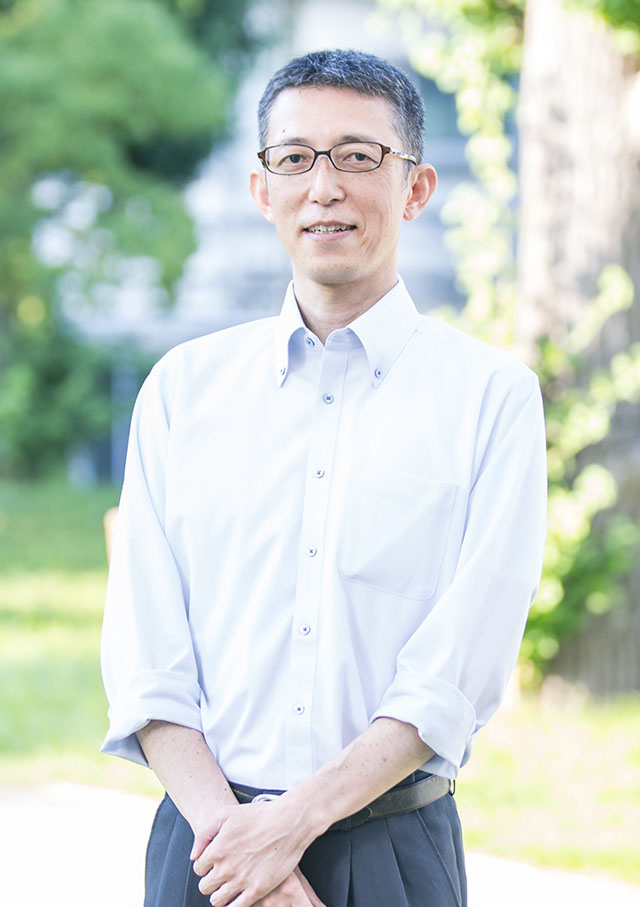
Professor Chihiro Yoshimura
School of Environment and Society, Department of Civil and Environmental Engineering
- March 2022 - PresentProfessor, School of Environment and Society, Tokyo Institute of Technology
- 2016 - 2022Associate Professor, School of Environment and Society, Tokyo Institute of Technology
- 2020Guest Lecturer, Yamagata University
- 2013Visiting researcher, The University of Newcastle, Australia
- 2013 - 2014Guest Lecturer, Kyoto University
- 2009 - 2016Associate Professor, Department of Civil Engineering, Graduate School of Science and Engineering, Tokyo Institute of Technology
- 2009Guest Lecturer, Gifu University
- 2006 - 2009Assistant Professor, Department of Civil Engineering, Faculty of Engineering, Gifu University
- 2005 - 2006JST research fellow, Interdisciplinary Graduate School of Medical and Engineering, University of Yamanashi
- 2002 - 2004JSPS Research Fellowship for Young Scientists (PD), Department of Surface Waters, Swiss Federal Institute of Aquatic Science and Technology
- 2002 - 2005JSPS Research Fellowship for Young Scientists (PD), School of Engineering, The University of Tokyo
- 2002D. Eng., Graduate School of Engineering, Tohoku University
- 2000 - 2001Studied abroad at Department of Surface Waters, Swiss Federal Institute of Aquatic Science and Technology
- 1999M.S., Graduate School of Engineering, Tohoku University
- 1997B.S., Department of Civil Engineering, Tohoku University
The Special Topics component of the Tokyo Tech Website shines a spotlight on recent developments in research and education, achievements of its community members, and special events and news from the Institute.
Past features can be viewed in the Special Topics Gallery.
Published: September 2022
. Any information published on this site will be valid in relation to Science Tokyo.















